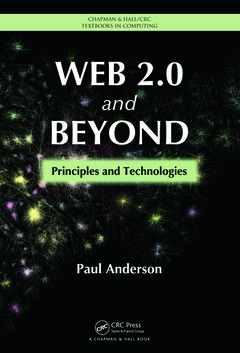Web 2.0 and Beyond Principles and Technologies Chapman & Hall/CRC Textbooks in Computing Series

Web 2.0 and Beyond: Principles and Technologies draws on the author?s iceberg model of Web 2.0, which places the social Web at the tip of the iceberg underpinned by a framework of technologies and ideas. The author incorporates research from a range of areas, including business, economics, information science, law, media studies, psychology, social informatics and sociology. This multidisciplinary perspective illustrates not only the wide implications of computing but also how other areas interpret what computer science is doing.
After an introductory chapter, the book is divided into three sections. The first one discusses the underlying ideas and principles, including user-generated content, the architecture of participation, data on an epic scale, harnessing the power of the crowd, openness and the network effect and Web topology. The second section chronologically covers the main types of Web 2.0 services?blogs, wikis, social networks, media sharing sites, social bookmarking and microblogging. Each chapter in this section looks at how the service is used, how it was developed and the technology involved, important research themes and findings from the literature. The final section presents the technologies and standards that underpin the operation of Web 2.0 and goes beyond this to explore such topics as the Semantic Web, cloud computing and Web Science.
Suitable for nonexperts, students and computer scientists, this book provides an accessible and engaging explanation of Web 2.0 and its wider context yet is still grounded in the rigour of computer science. It takes readers through all aspects of Web 2.0, from the development of technologies to current services.
What Is Web 2.0? THE SIX BIG IDEAS: User-Generated Content. Architecture of Participation. Data on an Epic Scale. Harnessing the Power of the Crowd. Openness. The Network Effect and Web Topology: What Size and Shape Is the Web and Why Does It Matter? WEB 2.0 SERVICES: Blogs. Wikis. Online Social Networks. Media Sharing. Social Bookmarking Sites. Microblogging Services. FRAMEWORK FOR THE FUTURE: Technology and Standards. Beyond Web 2.0. Epilogue. References. Index.
Paul Anderson is a writer and technology forecaster for Intelligent Content Ltd. and was recently technical editor for JISC TechWatch, a horizon scanning service for UK universities. A graduate in computer science from the University of Leeds, he has worked for more than 25 years in industry and academia as a software developer, technology transfer officer, and technology futures specialist. He has also written extensively for a range of education, trade, and current affairs publications and was awarded the EPSRC’s Computer Science Writer of the Year prize in 2007.
Date de parution : 05-2012
Ouvrage de 412 p.
17.8x25.4 cm
Thèmes de Web 2.0 and Beyond :
Mots-clés :
Company’s IPO; Www Virtual Library; Web 2.0; Open Directory Project; software engineering; 1920s Kings; Web 3.0; Open Source Soware; social Web; Code Open Source; iceberg model of Web 2.0; Small World Network; computer science; URI; Web topology; Scale Free Networks; Web 2.0 services; Open Application Programming Interface; technologies and standards of Web 2.0; Social Graph; Semantic Web; Blog Search Engine; cloud computing; Apache HTTP Server; Web Science; Preferential Attachment Mechanism; user-generated content; Search Engine; Network Eect; Social Bookmarking; MIT’s Centre; OSN; Net Neutrality; Collective Intelligence Operating; Creative Eort; Open Source; Power Law Distribution


